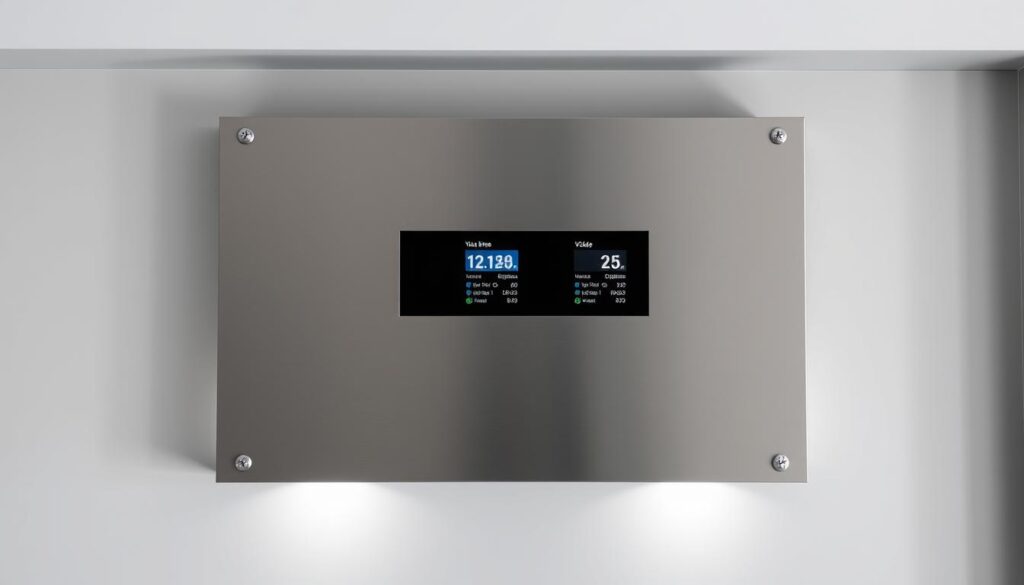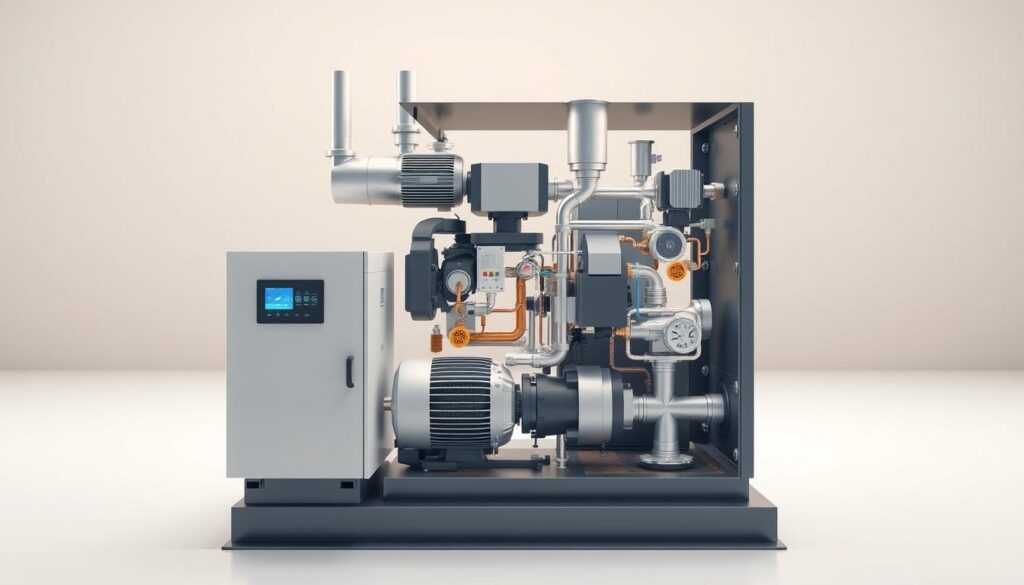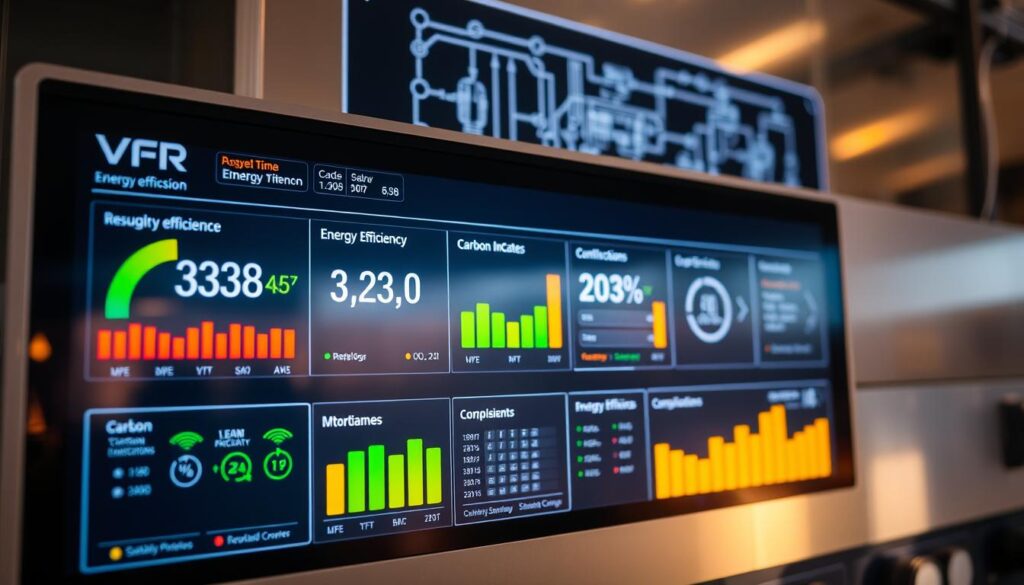Affiliate Disclosure
HVAC Guide Guys is a participant in the Amazon Services LLC Associates Program, an affiliate advertising program designed to provide a means for sites to earn advertising fees by advertising and linking to Amazon.
What is a VFD HVAC System? Are you fed up with high energy bills and poor HVAC performance? Imagine a technology that could change how your building’s cooling and heating work.

A Variable Frequency Drive (VFD) for HVAC is a modern solution for building management. It’s a smart device that controls electric motor speed. It adjusts frequency and voltage to meet system needs.
Using a VFD HVAC system gives you full control over your building’s climate. It lets motors run at the best speeds, saving energy and making equipment last longer.
Unlike old fixed-speed systems, a VFD HVAC system changes with the environment. It works better and uses less energy. By adjusting motor speed, it keeps temperatures just right and saves energy.
Key Takeaways
- VFDs control motor speed through frequency and voltage adjustment
- Provides significant energy efficiency improvements
- Offers precise temperature and airflow management
- Reduces mechanical stress on HVAC equipment
- Enables substantial long-term cost savings
- Supports advanced building management strategies
Table of Contents
Understanding VFD HVAC Systems: Basic Principles
Variable Frequency Drives (VFDs) change how we control motors in HVAC systems. They make managing motor speed and energy use more precise. This leads to better climate control.
VFDs adjust electrical frequency and voltage to meet specific needs. Unlike old HVAC controls, VFDs can change speed easily. This makes motor management more flexible and responsive.
Key Components of VFD Systems
- Rectifier: Converts AC power to DC
- DC Bus: Stabilizes electrical current
- Inverter: Transforms DC back to variable AC
- Control Unit: Manages overall system operation
Motor Speed Control Mechanism
The main idea of VFDs is to control motor speed by changing frequency. Lower frequencies mean slower speeds, and higher frequencies mean faster speeds.
Core HVAC Application Functions
VFDs are great for many HVAC tasks, such as:
- Air handling unit regulation
- Pump speed optimization
- Compressor performance management
- Cooling system efficiency enhancement
VFD technology bridges the gap between traditional HVAC controls and advanced energy management systems.
When you compare VFDs to old HVAC controls, you see big benefits. VFDs save energy, respond faster, and are more flexible. Using VFDs can cut energy costs and boost system performance.
Explore Our HVAC Shop
Looking for top-rated HVAC tools, parts, and accessories? Visit our shop and find the perfect solution for your needs.
Visit the ShopEnergy Efficiency and Cost Benefits
Variable Frequency Drives (VFDs) are changing the game for HVAC systems. They help save a lot of energy and cut down on costs in big buildings and factories.
Calculating Energy Savings
Using VFDs in HVAC systems opens up big energy-saving chances. HVAC systems can save a lot by controlling motor speed smartly:
- 20-60% less energy for fans and pumps
- Motor speed matches demand perfectly
- No extra power waste
Return on Investment Analysis
VFD technology saves money right away, not just on energy. You’ll get your money back fast because of lower bills.
| System Type | Annual Energy Savings | Estimated ROI Period |
|---|---|---|
| Air Handling Units | 35-45% | 1.5-2.5 years |
| Chilled Water Systems | 25-40% | 2-3 years |
| Cooling Tower | 20-35% | 1-2 years |
Utility Cost Reduction
Using VFDs wisely can cut down energy use and demand charges a lot. Smart motor control means lower bills and better efficiency.
“VFDs are not just an energy-saving solution; they’re a strategic investment in your building’s performance.” – HVAC Engineering Experts
VFD Operation in HVAC Applications
Variable frequency drives (VFD) have changed how HVAC systems work. They make your building more comfortable and save energy. This is because they control motors well, adapting to your environment’s needs.
VFDs manage motor speed smartly in HVAC systems. They adjust speed to save energy and work better. This means your system uses just the right amount of power for cooling or heating.
- Precise motor speed control
- Real-time demand response
- Reduced mechanical stress
- Enhanced system flexibility
To understand VFDs in HVAC, we need to look at how they work. Sensors watch the system and send data to the control unit. This data makes the motor speed change right away, keeping everything running smoothly.
| HVAC Application | VFD Control Strategy | Energy Savings |
|---|---|---|
| Air Handling Units | Airflow Modulation | 25-40% |
| Chilled Water Systems | Pump Speed Optimization | 30-50% |
| Cooling Towers | Fan Speed Adjustment | 20-35% |
Using smart VFD technologies can make your HVAC system much better. It saves money and keeps your environment comfortable.
Explore Our HVAC Shop
Looking for top-rated HVAC tools, parts, and accessories? Visit our shop and find the perfect solution for your needs.
Visit the ShopKey Components and System Integration
Knowing the parts of a VFD HVAC system is key for good installation and use. A variable frequency drive (VFD) is advanced tech that changes how your HVAC system uses electrical energy and motor performance.

Rectifier and DC Bus: Power Conversion Essentials
The rectifier is the first big part in a VFD HVAC system. It turns alternating current (AC) into direct current (DC). This step is vital for controlling electrical power to your HVAC gear.
- Converts incoming AC power to DC
- Stabilizes electrical input
- Prepares power for further manipulation
Inverter and Control Unit: Precision Management
The inverter changes DC power back into variable frequency AC. This lets your HVAC system adjust motor speed as needed. The control unit is like the brain, watching and controlling these electrical changes.
| Component | Primary Function | Impact on HVAC System |
|---|---|---|
| Rectifier | Convert AC to DC | Stabilize power input |
| DC Bus | Store electrical energy | Smooth power transmission |
| Inverter | Convert DC back to variable AC | Adjust motor speed precisely |
System Communication Interfaces
Modern VFD HVAC setups use advanced communication systems. These systems let your HVAC talk to building automation systems. This means you can watch and control energy use in real time.
When you think about adding a VFD to your HVAC, knowing these parts is important. It helps make your climate control system efficient, responsive, and energy-smart.
Installation Requirements and Best Practices
Installing a variable frequency drive for HVAC systems needs careful planning. You must pay attention to important details. This ensures your system works well and lasts long.
Before starting the vfd installation in hvac, consider these key points:
- Motor compatibility and selection
- Electrical environment assessment
- Proper mounting and ventilation
- Harmonic distortion mitigation
- Precise programming and configuration
Choosing the right motor is critical for a variable frequency drive for hvac. Inverter-duty motors with enhanced insulation are best. They handle the electrical stresses from the drive well.
When installing a vfd in hvac, the environment matters a lot. You need to check:
- Ambient temperature ranges
- Humidity levels
- Potential electrical interference
- Dust and contaminant exposure
Mounting the VFD correctly is important. It needs space for cooling and easy access for upkeep. Place it in a clean, dry spot, away from sunlight and vibrations.
Professional installation by certified technicians can significantly improve system reliability and performance.
Programming the VFD is all about fine-tuning it for your HVAC system. You’ll need to set up speed ranges, acceleration/deceleration times, and safety settings.
Common Applications in Commercial Buildings
Variable frequency drives (VFD) have changed HVAC systems in commercial buildings. They offer better control and save energy. A VFD HVAC system works well in many building uses. It helps managers control the environment better.
Commercial buildings use VFD technology for precise environmental control. VFD benefits in HVAC systems go beyond just speed control. They help manage energy and make equipment last longer.
Air Handling Units
Air handling units are key for VFD use. These systems use variable speed drives to:
- Adjust fan speeds based on real-time ventilation needs
- Save energy when not fully loaded
- Keep indoor air quality good
- Lessen wear on equipment
Chilled Water Systems
Chilled water systems get a big boost from VFDs. By adjusting pump speed, they manage cooling loads better. This leads to big energy savings.
| System Component | VFD Impact | Energy Savings |
|---|---|---|
| Chilled Water Pump | Speed Optimization | 20-40% |
| Circulation Pump | Demand-Based Control | 25-35% |
Cooling Tower Applications
Cooling towers see huge benefits from VFDs. By changing fan speeds, they:
- Keep condenser water at the right temperature
- Use less energy overall
- Reduce mechanical wear
- Respond faster
Knowing what a VFD HVAC system is means seeing how it changes old systems. It turns them into smart, adaptable networks.
Explore Our HVAC Shop
Looking for top-rated HVAC tools, parts, and accessories? Visit our shop and find the perfect solution for your needs.
Visit the ShopMaintenance and Troubleshooting Guidelines
Keeping your VFD HVAC system in top shape is key. Troubleshooting needs a step-by-step plan to find and fix problems early.
When you install a VFD in your HVAC, regular upkeep is vital. It stops sudden failures. Here are some tips to keep your VFD system working well:
- Do monthly visual checks
- Clean air filters and vents
- Check electrical connections
- Watch system performance
Common issues with VFD HVAC systems include:
| Issue | Potential Causes | Recommended Action |
|---|---|---|
| Overheating | Poor ventilation | Clean cooling fans, check ambient temperature |
| Communication Errors | Loose connections | Verify network cables, reset communication settings |
| Harmonic Distortion | Electrical interference | Install harmonic filters, check grounding |
Preventative maintenance is always more cost-effective than reactive repairs. Create a detailed maintenance plan. It should include:
- Quarterly system checks
- Annual professional inspections
- Regular software and firmware updates
- Calibration of sensors and controls
By sticking to these guidelines, you’ll boost your VFD HVAC system’s efficiency and reliability. This reduces downtime and extends your equipment’s life.
Energy Efficiency Regulations and Standards

Understanding energy efficiency rules is key for HVAC pros using variable frequency drive (VFD) systems. The U.S. has set clear guidelines to boost energy savings with VFD HVAC tech.
Important rules for VFD HVAC systems include:
- California Title-24 Energy Efficiency Standards
- Department of Energy (DOE) Motor Efficiency Requirements
- Energy Independence & Securities Act (EISA)
The California Energy Commission’s Title-24 requires VFDs for HVAC fans and pumps over 10 horsepower. These rules aim to cut energy use and support green building.
| Regulation | VFD Requirements | Impact on Energy Savings |
|---|---|---|
| Title-24 | Mandatory for systems >10 HP | Up to 50% energy reduction |
| DOE Standards | Premium efficiency motors | Minimum 85% motor efficiency |
| EISA Guidelines | Advanced motor control | Reduced electrical consumption |
Knowing these rules helps you boost energy efficiency and meet national green standards. Using VFD tech can cut costs and help the environment.
“Regulatory compliance is not just about following rules, but about creating smarter, more efficient HVAC systems.” – Energy Efficiency Expert
Keep up with new standards to get the most from VFD HVAC tech in business and industrial settings.
Explore Our HVAC Shop
Looking for top-rated HVAC tools, parts, and accessories? Visit our shop and find the perfect solution for your needs.
Visit the ShopFuture Trends and Innovations in VFD HVAC Technology
The world of variable frequency drive for HVAC systems is changing fast. Smart building tech is making VFDs smarter and more responsive. This leads to better energy management. New systems are getting smaller, more efficient, and connect easily with the Internet of Things (IoT).
Next-generation VFDs will offer unmatched precision and performance. New tech is working on better ways to handle power quality issues. Companies like Schneider Electric and Siemens are leading the way in creating VFDs that adjust to changing conditions.
Future VFDs will have better communication and predictive maintenance. These smart systems will let managers watch performance live, spot problems early, and save energy. Machine learning will help VFDs adjust on their own, making HVAC systems more efficient.
Sustainability is key, and VFDs will play a big role in saving energy. New innovations will aim to make drives that use less energy and work better with the grid. Expect to see more advanced, intelligent VFDs that change how we manage HVAC systems soon.

